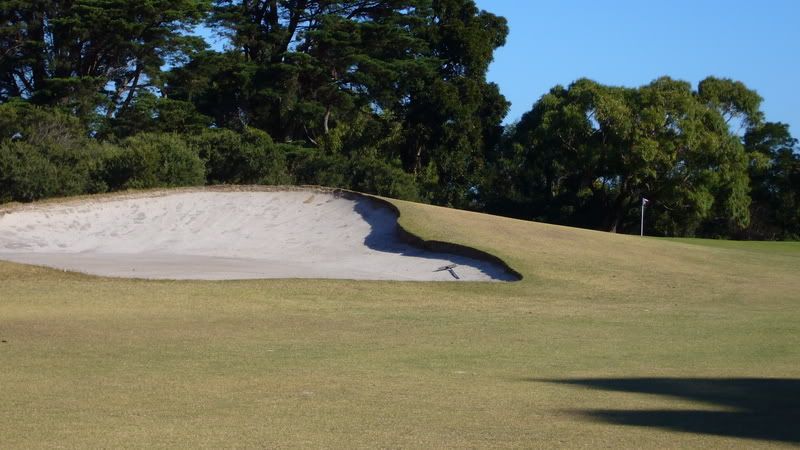It's probably not really a secret, given that MacKenzie actually wrote about it.
MacKenzie wrote how to make mounds appear natural: make them as waves, with "considerable" slope at the bottom but steep – even overhanging – slope near the top. He also wrote of scooping bunkers out of them and making a certain angle of concavity, although here it's not clear whether he saw the inherently naturalistic aspect of his recommended bunker concavity or just saw the proper angle as necessary to ensure balls rolled to the bunker bottom.
Anyway, I when I read all that I didn't really buy into the notion that angles and concavity could trick the mind into seeing manmade mounding look natural. I'm sure if you thought about it you would not have seen how mounding can be made to appear natural -- there are so many -- many! -- examples you can call on from your memory that prove the lie.
But recently I saw for once how the concept could be made to work -- it was like a bell tolling: carve out the bunker in a scallop whose apex was pitch-perfect with the apex of the mound! Let sand and mound meet at the peak -- the caldera of the bunker rising to meet the peak in a lovely curve of concavity.
I would add that this little secret represents a very high articulation of the craft of design: getting just the right angle of concavity can’t be all that obvious or easy, nor can scalloping the bunker to the mound’s apex. These mounds look so effortless and easy, nothing particularly special about them, but when you experience a course that has the work of Mac (including his henchmen) and of "someone else," I
guarantee you will notice the difference -- and how labored and ultimately inferior those others are!
So what's the secret that makes this "work"?
Personally, I think it has to do with our own expectations for what is "natural;" ocean waves must somehow shape (sorry!) those expectations or relate to some unstated heuristic our minds apply, subconsciously, in assessing the naturalism of the landscape. If it looks like a wave, it registers as "natural"…
1. Where have you seen this type of bunkering / mounding?
2. Does it fool anyone else's mind – does it look natural to you, too?
3. Is concavity
plus "apex bunkering" the secret to creating natural-looking mounds? Is it a secret law of obscurantist naturalism?
4. If yes, why? Do we
expect a "natural" peak to arc into a sharp peak based on what we see in oceans, mountain ranges or something?
BTW, this approach explains why many people note Mac's bunkers appear to disappear when seen from the rear - and maddeningly, seem to want to chalk this up to some sort of "camouflage stunt," as though the Doctor sought only to show off his camo knowledge as some parlor trick, a frivolity.
Examples to follow...
See how perfectly the bunker topline forms the ridge line, and how the ridge line carries on in a wave-like slope: The photo below illustrates perhaps another secret: don't fill the entire front face of the mound with a bunker. But this really is just another way of expressing the same principle as above: embed the bunker in a ridge. If you make the entire mound "face" a bunker, then you haven't created mound-bunker integration, have you? Good example of scalloping the face, too:
The photo below illustrates perhaps another secret: don't fill the entire front face of the mound with a bunker. But this really is just another way of expressing the same principle as above: embed the bunker in a ridge. If you make the entire mound "face" a bunker, then you haven't created mound-bunker integration, have you? Good example of scalloping the face, too: Pay close attention to the shadows in the picture below showing how bunkers relate to ridge lines -- and how that bunker embedded in the back-right mound reduces the apparent scale of what actually is a substantial mound:
Pay close attention to the shadows in the picture below showing how bunkers relate to ridge lines -- and how that bunker embedded in the back-right mound reduces the apparent scale of what actually is a substantial mound: Use the bunkers to trace this ridgeline all the way from upper right to lower left in the photo below:
Use the bunkers to trace this ridgeline all the way from upper right to lower left in the photo below: Photo below shows integration of bunkers into very subtle mounds and ridges:
Photo below shows integration of bunkers into very subtle mounds and ridges:
Thanks for any responses,
Mark